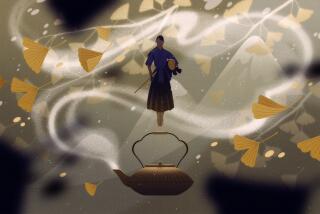The Power of Balance : <i> Qi Gong </i> Blends the Spiritual and Physical to Improve Health
- Share via
The professor faces the 30 Claremont Colleges students scattered about the wide room. He jumps up and down, arms stiff at his sides, legs straight. The students laugh.
Professor Si-Tu Jie then speaks in Chinese, and his interpreter, Sue Sheng, quickly translates his words.
“If we are not balanced, how can we move through life?” she asks.
Balance is one of the most elementary basics of qi gong, a blend of Taoist and Buddhist philosophies, breathing and meditation exercises and medicinal practices developed over 2,000 years in China. The discipline, Jie says, has influenced Asian art, philosophy, physiology, psychology and culture through its emphasis on acquiring knowledge through one’s physical and spiritual environment.
For two semesters, Jie, a certified qi gong master in China and head of the Shao-lin Wei-Tu Qi Gong School, has taught the Pitzer College class “Nature, Movement and Meditation in Qi Gong” through the environmental studies department. He and the Pitzer College faculty who developed the course believe that it is the first and only academic qi gong class at a mainstream college.
Though many independent practitioners teach qi gong exercises in the San Gabriel Valley, the Pitzer course tries to teach students about qi gong’s influence on Chinese civilization and its application to Western health practices, Jie said.
Dr. Angeline Douvas, assistant medical professor at USC, spoke at an October conference at Pitzer with Jie. They compared Western and Eastern styles of medical treatment--scientific and holistic. Jie’s demonstration of qi gong’s power had mixed results, Douvas recalled.
In a demonstration on two volunteers whose movements he tried to control without their seeing or touching him, one volunteer mimicked his movements, but the other did not. When the professor used qi gong on another volunteer, he correctly deduced a shoulder and knee injury but incorrectly diagnosed another ailment, she said.
Jie and Douvas concluded that patients should rely on Western medical technology and use aspects of qi gong-- herbs, teas, meditation and body awareness discipline--as a supplement.
“I think the overwhelming feeling (at the conference) is that they (Eastern and Western practices) can complement each other,” Douvas said.
She added that with the growing Asian population in Southern California, more Western doctors are accepting alternative health practices such as acupuncture. “Physicians have to be accepting . . . of patients’ orientations and philosophical needs . . . and a large number of patients are going to be Asians.”
The course’s popularity reflects the trend. This fall, the original limit of 20 was stretched to let 72 enrolled students get in. After the beginning-of-term shifts ended, about 30 students were still left, well over the typical Pitzer course size of 10 to 15.
For part of each class session, the students, some of them shoeless, stand in rows on the carpeted floor. Eyes closed, they slowly begin to raise their arms forward and upward in time to the delicate sound of a flute on tape. They try to breathe rhythmically.
This is the basic eight-minute drill, an integral part of each class. The drill is intended to induce a state between sleep and consciousness and relax the digestive system--a state specifically called qi gong.
“You feel clearer in brain, body and spirit,” said Harvey Mudd senior Mark Chalice after a class. Students from any of the Claremont Colleges can attend the qi gong class.
The drill is only the beginning of the practice of qi gong, said Jie, a trim man in his early 50s who has studied qi gong since childhood. He believes it takes at least 10 years of experience to be qualified to teach it. “To be a real master, you must devote your whole heart.”
According to Jie, several major schools teach qi gong in China, but hundreds of other schools in both China and the United States are not completely true to the essence of the practice. “So few really carry the traditional and scientific way. So many just collect some exercises.”
*
The theory behind qi gong includes the idea of an energy flow, or chi, which is channeled through various points of the body, called meridians. Acupuncture specifically pinpoints meridians.
In the class, which is given every Tuesday and Thursday afternoon for about two hours, students watched as Jie drew on the board Chinese characters and diagrams of the human body’s energy flow. Calligraphy, painting, philosophy, even cuisine all share the qi gong concept of achieving balance within one’s environment, he said.
“The course . . . brings a feeling and flavor of a different way of thinking of the world to the classroom,” said Tom Ilgen, dean of faculty and political science professor. “We’re not offering this as medical training but as a cultural experience.”
‘You feel clearer in brain, body and spirit.’
MARK CHALICE, Harvey Mudd senior
More to Read
Sign up for Essential California
The most important California stories and recommendations in your inbox every morning.
You may occasionally receive promotional content from the Los Angeles Times.










